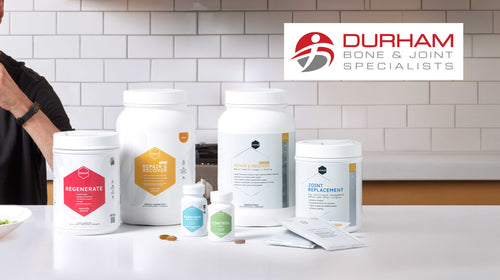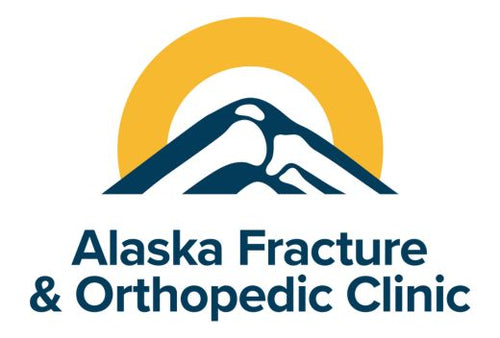Bone fractures are the most common musculoskeletal injury, with over 18 million per year, and the
average person will have at least 2 bone fractures in their lifetime. Whether it is a common fracture such as a
broken arm or collarbone fracture, or hard to heal fractures like scaphoid fractures, broken bones impact people of
all ages, but as we age our risk of fracture increases, and bone healing and recovery becomes more
difficult.
Your bones are complex, and the process of healing fractured bones is dynamic, and influenced
by a variety of factors and elements. Though different types of fractures have different clinical implications, they
all go through the same basic healing process.
In this article, we will dive into the composition of your
bones, how a fractured bone heals, and discuss how nutritional interventions may help speed up the healing process.
Composition of Our Bones
Made up of proteins, minerals and vitamins, bones provide shape, structure and mechanical support to our bodies. They also provide an environment for marrow (and the production of white blood cells) and act as a storage area for minerals (such as calcium). When a bone fractures, these it needs more of these nutrients as you go through the healing process.

The Bone Fracture and Healing Process
Different fractures have different recovery times and rehabilitation protocols, but all broken bones go through
the same healing process. This is true whether a bone has been cut as part of a surgical procedure or fractured
through other means like a sports injury or fall.
The bone healing process has three stages:
inflammation, bone production and bone remodeling.[2]

Nutrition to Improve the Bone Healing and Recovery Process
Depending on the severity of the fracture, bones can take between weeks to several months to heal. There are
multiple factors involved in this healing process[4], including:
- Severity of the fracture
- Excessive movement or mobility
- Age
- Nutritional status
The last factor – your nutritional status – plays an important but often neglected role in healing. As we stated earlier, bones are made up of proteins, minerals and vitamins. Any deficiency in these nutrients can compromise the bone healing process, both by prolonging the initial period of inflammation and by delaying the bone repair.[5]
Unfortunately, the reality is that most of us are undernourished and don’t know it. In the developed world, we
eat abundantly and therefore believe we are getting all the right nutrients into our body. But this isn’t the
case. A large study published in the Journal of Nutrition, evaluated over 16,000 Americans and found that many
are not meeting the minimum recommended thresholds for micronutrient intake. The study found that 93% of
Americans are deficient in Vitamin D, 45% in Vitamin A and 49% in calcium – three critical nutrients for bone
health and healing.[6]
We know insufficient intake of Vitamin A, Vitamin D, and calcium negatively
impacts the time and degree of bone healing, according to a study published in the Journal of Osteoporosis.[5]
In addition, malnourished elderly patients are at a greater risk of losing muscle mass – a condition known as
sarcopenia – which has been shown to increase the risk of delayed or compromised healing.[7][8]
Nutrition Recommendations for Better Bone Healing
If you have a bone fracture, your body needs more energy to support the demands of healing. During injury, your
body goes into a higher metabolic state as it uses more energy to support healing. Increasing your nutrition
intake with the proper foods and nutrients can help you keep up with the demands of your body during this
critical healing period. To optimize your body for healing, you should:
1) Consume more
calories during the healing period
After an injury, your metabolic rate increases between
15-30%.[9] To keep up with this accelerated metabolism, you should increase your caloric intake with more
healthy, whole foods and high quality supplements.
2) Increase your protein
intake
Muscle mass is a direct indicator of both fracture risk and delayed healing. A diet
high in protein will help preserve muscle mass, and has also been shown to improve bone healing.[10] At minimum
you should aim to consume at least 1 gram of protein per pound of body weight during the recovery
period.
3) Supplement your diet with targeted therapeutic nutrients during the recovery
phase
While diet is critical to healthy recovery, during this period it can be difficult to
consume sufficient nutrients through food alone. We recommend increasing your intake of key nutrients to support
your body’s demands. In particular:
- Protein – to support healing, tissue repair, and growth
- Vitamin A – to aid in wound and skin healing
- Vitamin D – to increase calcium absorption and improve bone healing
- Calcium – to build strong connective tissue
- Turmeric – to minimize inflammation around the wounded area[11][12]
Our bones are made up of proteins, minerals and vitamins, and it is critical that you replenish your bones with these important nutrients during the healing process. It is important to have these and a variety of nutrients present in your daily diet, as they can support healing. However taking all of these nutrients separately is not always feasible.
MEND Repair
& Recover was designed for this purpose. It contains all of the critical ingredients in sufficient
quantities to give a boost to bone fracture healing. With nutrients like whey protein, glutamine, vitamin A, vitamin
D, calcium, turmeric, boron, and more, MEND Repair & Recover supports bone and wound healing, reduces low level
inflammation, and optimizes healing.
Sources:
- Musculoskeletal Injuries: Type, Age, and Sex
- Foot Health Facts: Bone Healing
- Nature: Non-Union Bone Fracture
- Factors Affecting Fracture Healing
- Nutritional Aspects of Bone Health and Fracture Healing
- Foods, fortificants, and supplements: Where do Americans get their nutrients?
- An evaluation of the usefulness of consensus definitions of sarcopenia in older men: Results from the observational Osteoporotic Fractures in Men (MrOS) cohort study
- Bone fracture nonunion rate decreases with increasing age: A prospective inception cohort study
- Effect of environmental temperature on the metabolic response to injury
- Inhibition of fracture healing
- Therapeutic Roles of Curcumin: Lessons Learned from Clinical Trials
- Nutrition for Healing – Hospital for Special Surgery



